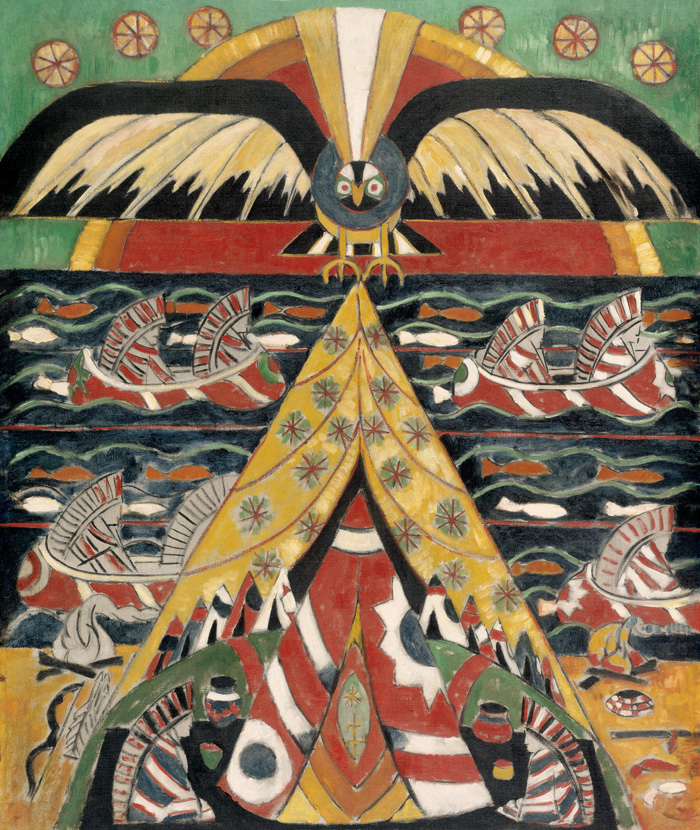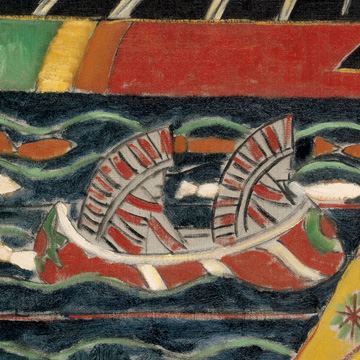
Indian Fantasy
Marsden Hartley, American, 1914
(oil on canvas)
North Carolina Museum of Art, Raleigh
Shall we meet a community of people living off the land?
Are there any clues in the painting that tell you who these people are? Look closely. What details do you see? There are teepees, bonfires, a bow and arrows, pottery, canoes, headdresses, fish in a stream, a bird with outstretched wings, and a sun and several stars in the sky. This painting portrays indigenous peoples from America. How did indigenous peoples from America live and interact with the natural world long ago? Do you think it is easier or more difficult to live the way we do today? How so? Consider the needs of food and shelter.
If I were to tell you this painting portrays Pueblo and Plains Indigenous peoples who lived in the southwest and west, would that help you to better understand this work of art? What is the environment like in the southwest and across the plains in the west? It is mountainous, desert and prairie land. Do the colors in this painting remind you of desert and prairie land? Yes, they are natural earth colors. What type of crops did these Indigenous peoples grow? We can’t tell from the details in the painting, but we do know that the environment and climate affect plant growth. How so? The quantities and qualities of nutrients, light, and water affect plant growth. What is the climate like in the southwest and across the plains? It is dry in the southwest, and there are dry and wet years across much of the plains. The Pueblo peoples grew mostly maize (corn), which is a plant that tolerates hot and dry conditions. Many of the Plains peoples in the West grew maize too as well as squash and beans. They also rode horses and hunted the buffalo as the buffalo migrated across the land.
This painting reminds me of a legend told by the Plains peoples. It is a Sioux legend called The Gift of Corn:
“Far from the village of his people lived an old hermit. Like his father and grandfather before him, the hermit’s teepee was made of buffalo skins, and his clothing was made of deer. He was happy to spend his days alone far from the others. Day after day, the hermit would roam the prairie collecting precious plants and roots, from which he would make powerful potions that he used as medicine. The hermit’s medicine was far superior to all other medicines. Warriors would travel for miles and miles in hope of getting medicine from the hermit for their tribe.
One day, after roaming across the plains in search of plants and roots, the old hermit came home, and it being very late, he lay down and dozed off to sleep. In his sleep he felt something rub against his foot. Waking up with a start, he saw a dark shape with an outstretched arm holding a flint-pointed arrow. The hermit thought, ‘This must be a spirit, for there is no one around here but me.’ A deep voice then said, ‘Old Hermit, I have come to take you to my home.’ The hermit answered, ‘I will come.’ He grabbed the flint-pointed arrow and stood up. He wrapped a robe made of deer skin around his shoulders and followed the voice outside. He stopped and looked around but saw no one. ‘Whoever you are, wait for me, for I do not know where to go,’ said the hermit. There was no answer. There was no sound. So the hermit went back inside his teepee and lay down and was soon fast asleep.
The next night the spirit came to him again. The hermit followed the dark shape outside but was left alone as before. The old hermit was very angry. He was determined to find out who was disturbing his night’s rest. The old hermit came up with a plan. The next evening he cut a hole in his teepee. He stood there and waited. Soon the dark shape came and stopped outside his teepee and said, ‘Grandfather, I have come to…’ The old hermit quickly aimed his bow and shot the flint-pointed arrow into the darkness. The arrow made a sound as if it had struck a sack of pebbles. The old hermit did not dare go out into the night. He waited until morning. At the break of dawn, the old hermit went outside. There on the ground lay a tiny heap of corn.
Now, it must be told that the old hermit had never seen corn before, so he bent down to pick up a kernel in his hand. He looked it over. Other corn kernels lay scattered along a trail that led across the prairie. The old hermit followed the path of corn kernels. He came to a small knoll, where the trail ended and where the grass had been scrapped clean and formed a large circle. ‘This trail stops at the edge of a circle,’ said the old hermit to himself. ‘This must be the home of whomever it was that came to me during the night.’ The hermit took his hatchet and dug down into the center of the circle. When he had dug a deep hole the length of his arm, he found a sack of dried meat. He continued to dig. Next he found a sack of Indian turnips. Then a sack of dried berries. There was one more sack. It was empty except for a handful of corn in one corner and a hole in the other corner, where his flint-pointed arrow had torn through. ‘The corn kernels must have fallen through this hole and scattered along the trail that guided me to this spirit’s home.’
Over the days and months to come the hermit taught his tribe how to keep their provisions when hunting buffalo. He explained to them how they should dig a pit, put their food into the pit, and cover the pit with soil. By this method the Sioux would keep food all season long, and when the seasons changed they would return to find everything as fresh as the day they were placed there. The tribe thanked the old hermit and gave him credit for not only teaching them how to preserve their food but also for discovering corn.”
What other factors besides the quantities and qualities of nutrients, light, and water affect the type of plants one can grow? The parts of soil affect the type of plants one can grow. What are the basic parts of soil? The basic parts of soil are sand, clay and humus. Can you describe these parts? Sand is loose particles of worn rock. Clay is the deposit of fine rock particles in water. Humus is the part of the soil that is decayed plant and animal matter. Sand, clay and humus can be found in the soil here in North Carolina. Can you find these parts in the soil where you live? The soil in North Carolina enables farmers to grow many crops, including soybeans, melons, cotton, blueberries, and tobacco. What crops are grown where you live?
Let’s look closely at this painting a moment longer. The natural, earth colors in the work represent the environment of the southwest and west. If you were to paint a landscape of where you live, what colors would you paint to represent the environment? Would you paint the blues and greens of water? The reddish-browns and grays of soil? The leafy-greens of trees? The grays and blacks of skyscrapers? Besides color, what other parts of art do you see in this painting? What about shape? Are the shapes repeated over and over? The teepees and fish and canoes and headdresses and stars in the sky are shapes that are repeated many times over and form patterns. What do the repeated patterns do to the painting? Do they create a kind of rhythm?

Indian Fantasy close-up
Imagine a line down the center of the painting. When both sides are exactly the same, how is it balanced? It is symmetrical. Are both sides of this painting exactly the same? No, there are some differences. When both sides are different, how is it balanced? It is asymmetrical. Try and pick out which parts on both sides of the painting are the same and which parts are different. Take your time. There are many similar and different details for you to discover. What mood does this type of balance give the painting? Is it full of energy? Or is it peaceful? Look closely. Do the objects in this painting have a lot of details? No, the artist left out many of the details. What details did he leave out? For example, he left out the scales, fins and eyes on the fish. What do you see in the painting besides the outline of the fish that tells you they’re fish? I’ll give you a clue. Do you see any wavy lines in the painting? The “fish” are swimming in what looks like the waves of a stream! When details are removed from a work of art, it is abstract. Many of the details have been removed from this work, so we can call it partially abstract.
How do you think this artist felt about indigenous peoples from America? How do the balance of the composition, the beautiful repeated patterns of the teepees and fish and canoes, and the earth colors make you feel? Look at the bird and sun at the top of the painting. Is the sun rising or setting? Is it morning or evening? Is the bird majestic, grand? Do you think the artist believed indigenous peoples from America are majestic like this bird? What do you think would be a good title for this piece? This artist loved indigenous American culture, but mostly what he learned about indigenous American life he learned from books and museums. Because he used his imagination, he called his painting Indian Fantasy.
§
Would you like to see Indian Fantasy in person? All you have to do is visit the North Carolina Museum of Art in Raleigh, North Carolina. Indian Fantasy is in the Modern galleries at the museum. Or perhaps you would like a tour. Tours of the collection are given daily, except for Monday when the museum is closed to the public. If you prefer, you can contact the museum ahead of time and arrange for you and your friends to have a private tour. I’m sure a docent at the museum would be happy to show you and your friends Indian Fantasy and many other works of art. Whether you visit the museum on your own or have a tour with a docent, it will be well worth your time!